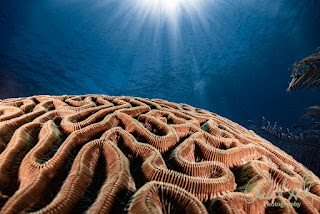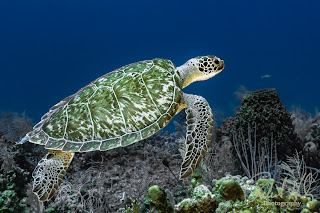Overcoming Backscatter in Underwater Photography: Advanced Techniques for Clarity
Advanced Techniques to Tame Backscatter:
- Buoyancy
Mastery: Achieving perfect buoyancy is crucial for any scuba diver. It is important to maintain a stable position and avoid disturbing sediment, which can contribute to backscatter and reduce visibility. To become a master of underwater stability, it is recommended to practice buoyancy control. Additionally, it is crucial to be aware of the environment you are in and to avoid touching or disturbing corals and other marine life at all times.
- Strobe
Positioning Precision: Strategic placement of strobes is essential for underwater photography. If you're using a single strobe, position it at either 10 or 2 o'clock, but not directed straight at the subject. Tilt it upwards and away from the subject so that only the end of the light cone illuminates the subject. When using two strobes, place them at 10 o'clock for the left strobe and 4 o'clock for the right strobe. Make sure that both strobes are angled away from the subject so that only the overlapping cone of light from both strobes reaches the subject. This helps to prevent the water column between your camera and the subject from being illuminated. Angling strobes outward is also helpful in preventing light from bouncing off particles in the water. To avoid backscatter, position the strobes strategically to light up your subject. The use of extension arms for your strobe(s) greatly reduces backscatter by ensuring that the angle of the strobes is greatly different than the lens angle to the subject.
- Snoots for Precision: A snoot is a cone or cylinder-shaped accessory that can be attached to a strobe or flash to help focus and direct the light output. Narrowing the beam of light, reduces light spill and minimizes the chance of illuminating particles in the water, which can cause backscatter and reduce image clarity. Investing in a snoot can be especially useful for macro photography, where precise lighting control is key. With a snoot, you can highlight specific areas of your subject or create dramatic lighting effects. It can also be helpful for creative portraiture or still-life photography. When choosing a snoot, consider the size of your strobe or flash and the type of photography you will be doing. Some snoots have adjustable apertures for even more control over the light output. Experimenting with different snoot shapes and sizes can also produce interesting and unique lighting effects. Overall, a snoot is a valuable tool for underwater photographers who want more control over their lighting and better image quality. It may require some practice and experimentation to master, but the results can be well worth the investment.
- Optimal Strobe Power: When adjusting strobe settings, it's important to consider the power of the strobe and how it can affect the overall quality of the image. While a powerful strobe can provide ample illumination, it can also create backscatter, which can detract from the clarity of the photo. To find the optimal setting, it's important to experiment with different strobe power levels and adjust accordingly. This will help you strike a balance between providing sufficient illumination and avoiding backscatter. Another factor to consider is the distance between the strobe and the subject. If the strobe is too close, it can cause overexposure and harsh shadows. On the other hand, if it's too far, the subject may appear underexposed and lack detail. In addition to strobe settings, it's also important to consider other factors such as camera settings and shooting technique. By paying attention to these details, you can achieve high-quality underwater photography that truly captures the beauty of the ocean and its inhabitants.
- Higher f-stop for Depth: Depth of field refers to the range of distance that appears acceptably sharp in a photograph. It is a fundamental concept in photography and can be used to create stunning images with various creative effects. Aperture is one of the three main factors that affect depth of field, the others being the distance between the camera and the subject and the focal length of the lens. The aperture is the size of the opening in the lens through which the light passes to reach the camera sensor. The larger the aperture, the shallower the depth of field. Conversely, the smaller the aperture, the greater the depth of field. In other words, a low f-stop number (e.g. f/1.4) will result in a very shallow depth of field, while a high f-stop number (e.g. f/22) will produce a deep depth of field. When you increase your aperture (using a higher f-stop number), more of the scene will be in focus, which is particularly useful when shooting landscapes where you want everything to be sharp and in focus. This adjustment can also help reduce the visibility of backscatter (unwanted specks of debris in the water) in underwater photography, particularly in the background.
- Strategic Positioning and Distance: When taking underwater photographs, it's important to keep in mind the distance between your camera and the subject. Maintaining an optimal distance not only helps you capture clear and sharp images, but it also minimizes the amount of water between your camera and the subject. This, in turn, reduces the risk of backscatter interference, which can occur when light reflects off particles in the water and creates unwanted speckles in your images. To ensure that you maintain an optimal distance from your subject, it's important to approach slowly and carefully. Try to avoid sudden movements that could startle the subject or disturb the surrounding water. If possible, use a zoom lens to get closer to the subject without having to physically move closer. Overall, keeping an appropriate distance between your camera and the subject is an important aspect of underwater photography that can greatly enhance the quality of your images. So, always keep this in mind while capturing the beauty of the underwater world.
- Backscatter Reduction Filters: When it comes to taking underwater images, capturing clear and vibrant photos can be a challenge. The presence of unwanted artifacts such as backscatter can greatly affect the quality of your images. Fortunately, there are specialized filters designed to absorb wavelengths contributing to backscatter. These filters work by enhancing clarity and color balance, thus minimizing the impact of unwanted artifacts in your underwater images. By utilizing these filters, you can capture stunning underwater images that are vibrant, balanced, and free from unwanted artifacts. This is particularly important for underwater photographers who want to capture the beauty of the marine environment, as well as for researchers who need accurate and clear images for scientific analysis. Investing in specialized filters is a must for anyone serious about underwater photography or research.
- Post-Dive Rinse Routine: It is essential to implement a thorough post-dive rinse for your camera and housing to maintain your equipment's optimal condition for clear shots on subsequent underwater excursions. Salt and debris accumulated during the dive can cause damage to your equipment if left untreated. Therefore, it is crucial to rinse your camera and housing with fresh water after every dive to remove any salt or debris. Once you have completed the rinse, allow the camera and housing to dry completely before storing them in a cool, dry place. By taking the time to implement a thorough post-dive rinse, you can extend the life of your camera, housing, extension arms, strobes, lights, prevent corrosion, and ensure that your equipment is always ready for the next underwater excursion.
- Manual Focus Mastery: Mastering manual focus in challenging situations is one of the key skills that every underwater photographer must learn. The precision focusing technique ensures that your images are sharp and clear, and minimizes the risk of backscatter ruining your compositions. By practicing manual focus techniques, you can achieve consistent results and take your underwater photography to the next level. One of the most challenging aspects of underwater photography is the constantly changing conditions. The light, visibility, and subject distance all vary, making it difficult to rely on autofocus. Manual focus gives you complete control over the focus point, allowing you to fine-tune your composition and get the shot you want. To get started with manual focus, you need to understand the mechanics of your camera's focus system. Learn how to adjust the focus ring and how to use the focus aids in your camera's viewfinder. Experiment with different focusing techniques such as zone focusing, hyperfocal distance, and split-image focusing. With practice and patience, you can master manual focus and take your underwater photography to the next level. Remember to always prioritize safety and respect for the marine environment while capturing stunning images.
- Post-Processing Expertise: Post-processing tools play a crucial role in the final outcome of an edited image. When used effectively, they can help refine the image and eliminate any distracting artifacts that may have been introduced during the capture process. One such example is backscatter artifacts that may appear in underwater photos due to the reflection of light off particles in the water. Cloning, healing, and selective adjustments are some of the most widely used post-processing techniques that can help remove such artifacts. Cloning involves copying a portion of the image and pasting it over the backscatter area to eliminate it. Healing involves blending the backscatter area with its surroundings to create a smooth transition. Selective adjustments allow the user to adjust specific areas of the image, such as brightness, contrast, and color, without affecting the rest of the image. It is important to note that post-processing should be used only as a final line of defense after all other techniques have been exhausted. Over-reliance on post-processing can lead to a loss of image quality and naturalness. Therefore, it is essential to use these tools judiciously and with a keen eye for detail to ensure that your final images are free from distractions and look as natural as possible.
Conclusion:
It's important to note that backscatter can be a major obstacle in capturing clear and stunning underwater photos. But with patience and persistent practice, you can fortify your skills, enabling you to capture the mesmerizing beauty that resides beneath the waves – unblemished by the interference of backscatter.
With these tools and techniques at your disposal, you can dive in, explore, and enjoy the artistry of crystal-clear underwater photography. So grab your gear, head to the nearest body of water, and start capturing the beauty that lies beneath the surface.
Stay tuned and "Follow" for upcoming blogs on underwater photography tips and tricks for more in-depth insights. Please leave your comments and suggestions. Enjoy your diving and shooting experience!
I am eagerly anticipating your valuable feedback and suggestions.
Sincerely,
Bob Herb
|
|





Comments
Post a Comment
Please let me know your comments.